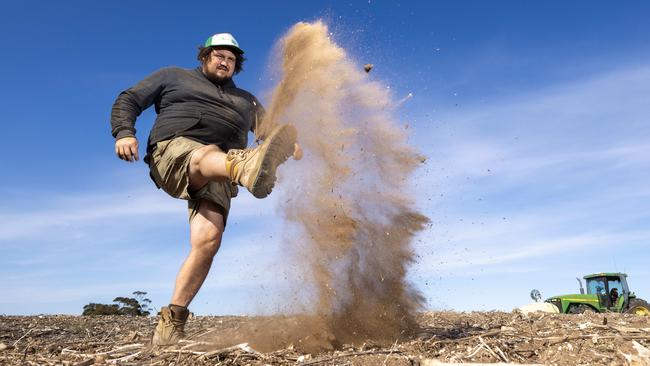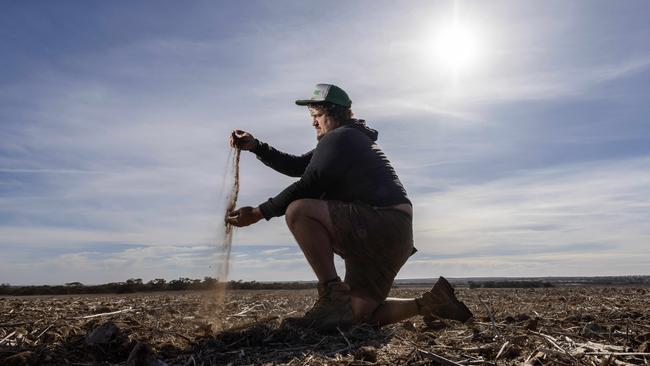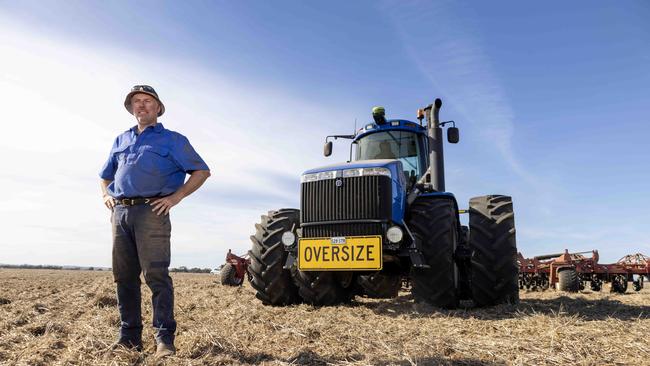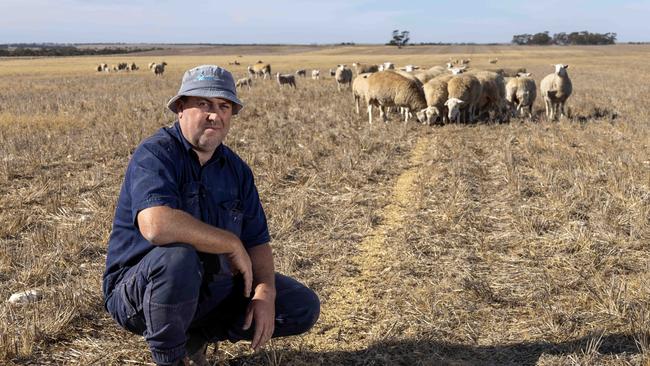‘We are screwed’: Farmers face return of nightmare dry spell
The dry start to the year could spell disaster for SA farmers – with one warning conditions of Millennium Drought could return if it doesn’t rain soon.
SA News
Don't miss out on the headlines from SA News. Followed categories will be added to My News.
The historically dry start to the year could spell disaster for SA farmers, with hay supply exhausted and feed scarce.
The state is in the middle of a prolonged dry period, causing feed scarcity, and a Mallee farmer has warned scenes during the 2001-09 Millennium Drought of livestock dying in paddocks could return – if we don’t get rain in a matter of weeks.
Daniel Marrett, who crops about 2400ha and runs 500 sheep in the state’s Mallee region, described the situation as “dire”.

“Farmers have exhausted feed options in their paddocks very quickly,” he said.
“If we don’t get rain soon, we are screwed.”
He said all his hay reserves – untouched for two years – were snapped up and sold off a few weeks ago, as farmers desperately tried to feed stock.
Mr Marrett said getting fodder from interstate was an option, but not practicable for all as an extra cost farmers cannot absorb.
The Advertiser understands some farmers had resorted to giving their stock away.
“With prices of animals on the slide, fodder is expensive … the problem gets bigger and bigger and there’s just no end to it,” Mr Marrett said.
He said while the lack of rain put serious pressure on his cropping operations, predictions of better rainfall in July to August gave him hope he could recover from a slow start.
He said he could not remember a time it had been this dry for this long – and began dry sowing low-risk crops in the hope rain comes soon.

“When they do get rain, it’s still six weeks until they get any feed. By that time it might be too cold so they might not get feed until August,” Mr Marrett said.
He said the last good rain he had at his property was back in January.
“We’ve had about 2mm since then … it’s absolutely ridiculous.”
Bureau of Meteorology spokesperson climatologist Dr Simon Grainger told The Advertiser the February to April rainfall for most of southeast South Australia was in serious deficiency; meaning it was in the lowest 10 per cent of all years since 1900.
“Soil moisture in April for most of the south of South Australia was very much below average, in the lowest 10 per cent of years since 1911, affecting the water available for agriculture, including crops,” he said.

Early dry weather could hurt farmers for months to come
Fellow Mallee farmer Rick Lienert said the lack of feed was a core issue with farmers scrambling to save their livestock operations.
“There will be a lot of pain for a while … if it doesn’t rain before the feed is completely gone, farmers have to buy it all in … if they can get it,” he said.
“We had … hay in the sheds and we thought we’d never sell. All of a sudden it’s gone.
“It comes at a price point. If it’s going to cost too much to feed (livestock) … there is no point in doing it.
“So you’ve got to try and sell them and you’re selling them at a very low price … the dry weather is affecting us all in all sorts of ways.”
He said once it rains, usable feed was still six weeks away.
For his cropping operations, the lack of rainfall might result in some of his paddocks laying bare.
“We haven’t sowed any canola yet, we’ve been holding off until it rains and if it doesn’t rain until the middle of next month or even later, we might have to leave paddocks out for the year.”
He said most farmers had opted to put in lower risk crops and “hope for the best.”
Problems ‘cascading’ for livestock producers
Livestock SA president Joe Keyes said the “alarming” situation was being felt statewide.
“Pretty much the whole state has experienced a dry time; the West Coast, the Yorke Peninsula and even the Pastorals need more rain,” he said.
“Feed reserves in paddocks are low but people are also going through grain and hay at quite an alarming rate,” he said.
“The amount of reserves around is starting to dwindle, feed prices are starting to increase so there are a lot of cascading effects.”
“As people move towards lambing and calving, that is peak nutrition time. The longer we go, the more dire the situation gets … a rain will fix it, but if we don’t get a rain we have to think about what happens next.”
He said a good spring could mitigate the damage for producers.
“The longer the wait (for rain) the soil temperatures get cooler and the response to the rain will be a lot slower.
“I guess we’ve been lucky at the moment that we haven’t yet had any frost.”

No rain causing pain for even the best prepared
The lack of rain is hurting even the most prepared – with sheep farmer Grant Johnson still feeling the pinch, despite being prepared for a prolonged dry period.
Mr Johnson and his wife Carolyn established the Carcuma North Poll Merino Stud farm in 2007.
He said they were prepared for the summer months and to have enough to get their stock through lambing, but he could not remember it being this dry this long in his 20 years on the farm.
“Feed in the paddocks is disappearing quickly,” he said.
“A lot of people – us included – are lambing their ewes at the moment. So we need paddocks of feed of reasonable quality to keep them growing.
“Ewes through pregnancy and through lambing require a lot of energy.”
He conceded as reserves dwindled, the situation would become severe if the rain does not come.
He said others were already feeling the pinch.
“We’ve been fortunate that we store a good portion of our cereal grains to feed the sheep over summer … but that’s not the case of everyone,” he said.
“It’s an added expense to try and find hay … that’s if you can find it.”




